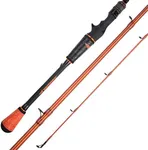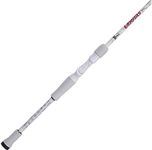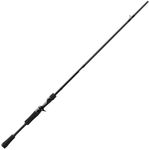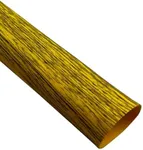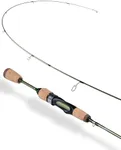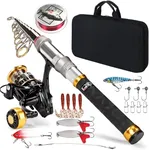Buying Guide for the Best Crankbait Rods
Choosing the right crankbait rod is essential for enhancing your fishing experience and increasing your chances of success. Crankbait rods are specifically designed to handle the unique demands of crankbait fishing, such as casting distance, sensitivity, and the ability to handle the fight of a fish. When selecting a crankbait rod, it's important to consider several key specifications to ensure you get the best fit for your needs. Understanding these specs will help you make an informed decision and find a rod that matches your fishing style and preferences.Rod LengthRod length is the measurement from the tip of the rod to the butt. It affects casting distance, accuracy, and leverage when fighting a fish. Crankbait rods typically range from 6 to 8 feet. Shorter rods (6-7 feet) offer better accuracy and are easier to handle in tight spaces, making them ideal for fishing in smaller bodies of water or around heavy cover. Longer rods (7-8 feet) provide greater casting distance and better control over the lure, which is beneficial for open water fishing and covering more area. Choose a rod length based on the type of water you fish in and your casting preferences.
PowerPower refers to the rod's ability to handle weight and is often categorized as light, medium, or heavy. It indicates how much force is needed to bend the rod. For crankbait fishing, medium to medium-heavy power rods are commonly used. Medium power rods are suitable for smaller crankbaits and lighter lines, providing a good balance of sensitivity and strength. Medium-heavy power rods can handle larger crankbaits and heavier lines, offering more backbone for fighting bigger fish. Consider the size of the crankbaits you use and the type of fish you target when selecting the power of your rod.
ActionAction describes how and where the rod bends when pressure is applied. It ranges from slow to fast. Slow action rods bend throughout the entire length, providing a more parabolic bend, which is ideal for keeping fish hooked on treble hooks commonly found on crankbaits. Moderate action rods bend in the middle, offering a balance between sensitivity and hook-setting power. Fast action rods bend near the tip, providing quick hook sets and better sensitivity but less forgiveness. For crankbait fishing, moderate to slow action rods are preferred as they help prevent fish from throwing the hook during the fight. Choose the action based on your preference for sensitivity and hook-setting ability.
MaterialRod material affects the rod's weight, sensitivity, and durability. Common materials include graphite, fiberglass, and composite (a combination of both). Graphite rods are lightweight and highly sensitive, making them great for detecting subtle bites. However, they can be more brittle. Fiberglass rods are more durable and have a slower action, which is beneficial for crankbait fishing as they provide a more forgiving bend. Composite rods offer a balance of sensitivity and durability, combining the best features of both materials. Consider the trade-offs between sensitivity and durability when choosing the material of your crankbait rod.
Handle TypeThe handle type affects comfort and control during fishing. Handles are typically made from cork, EVA foam, or a combination of both. Cork handles are lightweight, provide a good grip, and are comfortable to hold, but they can wear out over time. EVA foam handles are more durable and resistant to wear, offering a comfortable grip even when wet. Some rods feature split-grip handles, which reduce weight and provide better balance. Choose a handle type that feels comfortable in your hand and suits your fishing style. Consider the conditions you fish in and how long you typically hold the rod when making your decision.
